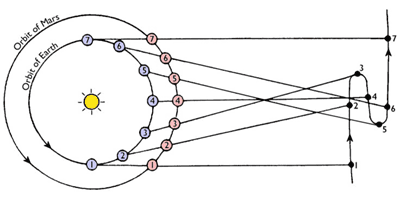A not-all-together sane way of showing a class how retrograde motion works!
WATCH VIDEO
- Planetary Orbits
- Solar System
- Observational Astronomy
Theory:
When an object in the sky appears to move backwards with respect to the common motion of the system, it is said to be in retrograde motion. The most common example of retrograde motion within the solar system is the apparent westward motion of Mars. Mars has a larger orbit than Earth, and therefore it moves more slowly in its orbit. Both planets move eastward, but since the Earth moves faster than Mars in its orbit, Mars will be overtaken by the faster-moving Earth. With respect to the background stars, the motion of Mars will then appear to slow down and reverse direction as the Earth comes to the point in its orbit where it is closest to Mars. The apparent retrograde part of Mars's orbit occurs for a few months before it returns to motion in the eastward direction. A schematic of the motion is shown in Figure 1:

Figure 1: Apparent retrograde motion of Mars
(http://www.splung.com/cosmology/images/retro.gif)
In this demonstration, Earth is represented by a camera on a rolling chair. Mars is represented by a styrofoam ball hanging from a stand on wheels. The camera is pushed in a "circular" orbit by an assistant while the Mars apparatus is also pushed in a circular orbit, at a slower speed. As the camera person keeps the camera on Mars, it appears to move backwards as its orbit is overtaken. This demonstration can be done without the camera and just with two student volunteers.
- two student volunteers
- a rolly-chair and camera
- tennis ball on boom
- background reference
- Situate the two volunteers in an area where a large circular path can be made.
- Have the students walk in their circular orbits, facing each other at all times (this can take some practice).
- The student representing Earth should move in a faster orbit than the student representing Mars, and the orbits should both be at the frontmost point of their orbit at the same time.
- If the students are moving counterclockwise, the student representing Earth will view Mars moving to the left, slow down and apparently move to the right as they overtake Mars' orbit.



